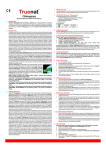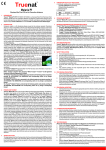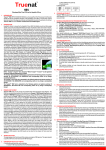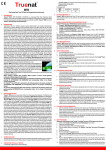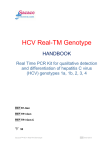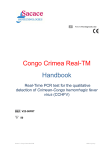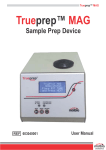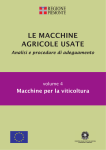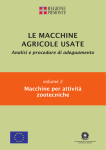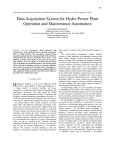Download Dengue - Molbio Diagnostics
Transcript
can be printed via Bluetooth using the Truelab™ micro PCR printer or transferred to the lab computer/or any remote computer via Wifi network or GPRS network. Upto 1000 results can be stored on the analyzer for future recall and reference. Dengue 4. TARGET SELECTION The target sequence for this kit has been taken from the 3' Untranslated region (UTR) of the Dengue genome. The region selected is specific to and represents all four serotypes (DEN 1 to DEN 4) of Dengue virus. 5. CONTENTS OF THE Truenat™ Dengue KIT A. Individually sealed pouches, each containing a 1. Truenat™ Dengue micro PCR chip. 2. Microtube with freeze dried RT PCR reagents. 3. DNase & RNase free pipette tip. 4. Desiccant pouch. B. Package Insert. Chip-based Real Time PCR test for Dengue 1. INTENDED USE Truenat™ Dengue (REF 601050005 / 601050020) is a chip-based Real Time Reverse Transcription Polymerase Chain Reaction (qRT-PCR) test for the quantitative detection and diagnosis of Dengue virus in human blood/serum/plasma specimen and aids in the diagnosis of infection with Dengue. Truenat™ Dengue runs on the Truelab™ Uno Real Time micro PCR Analyzer. 2. INTRODUCTION Dengue infection is a leading cause of morbidity and mortality in the tropical and subtropical regions of the world with a huge economic cost associated with it. As many as 100 million people are estimated to be infected with Dengue, yearly. Dengue infection is caused by any one of the four related serotypes of the Dengue virus (DEN-1, DEN-2, DEN-3, or DEN-4). Dengue, an RNA virus, is transmitted by the bite of an infected, day biting, Aedes mosquito (Aedes aegypti and Aedes albopictus) and is characterized by a sudden onset of high fever, headache, retro orbital pain in the back and limbs (break-bone fever), lymphadenopathy and maculopapular rash. Depending on the immune response, Dengue infection is classified as primary or secondary. Primary Dengue infection is usually self limiting and uncomplicated. Life threatening conditions such as Dengue Haemorrhagic Fever (DHF) and Dengue Shock Syndrome (DSS) are more severe forms of Dengue usually associated with secondary infection and is fatal if not treated early. Thus early diagnosis and treatment is crucial in the management of Dengue fever. Current methods of diagnosis of the disease include viral isolation, serologic tests and molecular methods. Serology based tests qualitatively detect IgM and IgG antibodies that appear much later during the convalescent stage or detect the NS1 antigen during the late acute phase and early convalescent phase. However, these methods are known to show cross reactivity with other flaviviruses and have limitations of sensitivity. Viral isolation and molecular techniques such as Polymerase Chain reaction (PCR) or Real Time PCR are much more sensitive and confirm infection with dengue, immediately upon onset of symptoms, during the acute (viremic) phase. However, viral isolation and PCR or Real Time PCR tests have so far been restricted to centralized reference laboratories as they require skilled manpower and elaborate infrastructure. Also the turnaround time for results could take a few days. The Truelab™ Real Time micro PCR System enables decentralization and near patient diagnosis of Dengue by making real time PCR technology rapid, simple, robust and user friendly and offering “sample to result” capability even at resource limited settings. This is achieved through a combination of lightweight, portable, mains / battery operated Truelab™ Uno Real Time micro PCR Analyzer and TrueprepTM MAG Sample Prep Device and room temperature stable Truenat™ chip-based Real Time PCR test and TrueprepTM MAG Sample Prep kits so that even the peripheral laboratories with minimal infrastructure and minimally trained technician can easily perform these tests routinely in their facilities and report PCR results in less than an hour. Moreover, with these devices PCR testing can also be initiated in the field level, on site. Truenat™ Dengue is a disposable, room temperature stable, chip-based Real Time PCR test with dried down PCR reagents for performing a Real Time PCR test for detection of Dengue and runs on the Truelab™ Uno Real Time micro PCR Analyzer. Only six (6) µL of purified RNA to be added to the reaction well for the analysis. The intelligent chip also carries test and batch related information including standard values for quantitation. The Truenat™ Dengue chip-based Real Time PCR test also stores information of used chips to prevent any accidental re-use of the chip. NOTE : Truelab™ / Truelab™ Uno / Trueprep™ MAG / Truepet™ / Truenat™ are all registered trademarks of Molbio Diagnostics (P) Limited. The Truelab™ Real Time micro PCR Analyzer is protected by the following patents and patents pending: IN 2313/CHE/2007, WO 2009/047804 and corresponding claims of any foreign counterpart(s) thereof. The Truenat™ micro PCR chip is protected by the following patents and patents pending: IN 2312/CHE/2007, WO 2009/047805 and corresponding claims of any foreign counterpart(s) thereof. The Truenat™ Dengue test is protected by the following patents and patents pending: IN 2162/CHE/2010, WO 2012/014116 and corresponding claims of any foreign counterpart(s) thereof. 3. PRINCIPLE OF THE TEST Truenat™ Dengue works on the principle of Real Time Reverse Transcription Polymerase Chain Reaction (qRT-PCR). The RNA from the patient blood sample is first extracted using Trueprep™ MAG Sample Prep Device and Trueprep™ MAG Blood sample prep kit and six (6) µL of the purified RNA is then dispensed into a microtube containing freeze dried PCR reagents, including reverse trancriptase (RT). After allowing approximately 20 seconds for the dried PCR reagents to get hydrated with the RNA sample, the entire contents are pipetted out and dispensed into the reaction well of the Truenat™ Dengue chip-based Real Time PCR test. The Truenat™ Dengue chip-based Real Time PCR test is then inserted in the Truelab™ Uno Real Time micro PCR Analyzer where the RNA is first converted into complementary DNA (cDNA) by the RT enzyme and further thermal cycling takes place. A positive amplification causes the dual labeled fluorescent probe in the Truenat™ Dengue chipbased Real Time PCR test to release the fluorophore in an exponential manner which is then captured by the built-in opto-electronic sensor and displayed as amplification curve on the analyzer screen, on a real time basis during the test run. The Cycle threshold (Ct) is defined as the number of amplification cycles required for the fluorescent signal to cross the threshold (i.e. exceed the background signal). Ct levels are inversely proportional to the amount of target nucleic acid in the sample (i.e. the lower the Ct level the greater is the amount of target nucleic acid in the sample). Ct value is linearly correlated with amount of target RNA copies present in the sample, enabling quantitative estimation of the analyte. Standard values for every batch are preset in the Truenat™ Dengue chip-based Real Time PCR test and the analyzer automatically compares these with the Ct value of the test sample to provide a quantitative result. In the case of negative samples, amplification does not occur and a horizontal amplification curve is displayed on the screen during the test run. At the end of the test run, Dengue “DETECTED” or “NOT DETECTED” result is displayed and in positive cases, Ct values and copies per milliliter (cp/ml) is displayed on the screen. Based on the Ct of the internal positive control (IPC), the validity of the test run is also displayed. The IPC is a full process control that undergoes all the processes the specimen undergoes - from extraction to amplification thereby validating the test run from sample to result. Absence of or shift of IPC Ct beyond a pre-set range in case of negative samples invalidates the test run. While IPC will co-amplify in most positive cases also, in some specimen having a high target load, the IPC may not amplify, however the test run is still considered valid. The results REF 601050005 601050020 5T 20 T 6. STORAGE AND STABILITY Truenat™ Dengue is stable for one year from the date of manufacture if stored between 2-30oC. It is also stable for upto three (3) months at temperatures up to 40° C. Avoid exposure to light. 7. MATERIALS REQUIRED BUT NOT PROVIDED WITH THE KIT Truelab™ Real Time micro PCR Workstation (REF 603010001) consisting of 1. Trueprep™ MAG Sample Prep Device (REF 603040001). 2. Truelab™ Uno Real Time micro PCR Analyzer (REF 603020001). 3. Truelab™ micro PCR Printer (REF 603050001). 4. Truepet™ Precision Micropipettes - 6µL, 50µL, 100µL, 500µL, 1000µL. (REF 604010006 / 604020050 / 604030100 / 604040500 / 604051000). Also required additionally are: TrueprepTM MAG Blood Sample Prep Kit (REF 609100050), Truenat™ Universal Control Kit (REF 601100008), DNase and RNase-free pipette tips (2 - 200µL / 200 1000µL microtips) with filter barrier, which may also be procured from Molbio (REF 604072200 / REF 604062010 respectively), Powder free disposable gloves, waste disposal container with lid. 8. SPECIMEN PREPARATION Truenat™ Dengue requires purified nucleic acids from whole blood, serum or plasma specimen that are extracted using the TrueprepTM MAG Sample Prep Device and TrueprepTM MAG Blood Sample Prep Kit (Refer to the User Manual of TrueprepTM MAG Sample Prep Device and the package insert of TrueprepTM MAG Blood Sample Prep Kit for details). 9. SAFETY PRECAUTIONS 1. For in vitro diagnostic use only. 2. Bring all reagents and specimen to room temperature (20 - 30 oC) before use. 3. Do not use kit beyond expiry date. 4. Carefully read the User Manuals and package inserts of all the components of the Truelab™ Real Time micro PCR System before use. 5. All materials of human origin should be handled as though potentially infectious. 6. Do not pipette any material by mouth. 7. Do not eat, drink, smoke, apply cosmetics or handle contact lenses in the area where testing is done. 8. Use protective clothing and wear disposable gloves when handling samples and while performing sample extraction. 10. PROCEDURAL PRECAUTIONS 1. Check all packages before using the kit. Damage to the packaging does not prevent the contents of the kit from being used. However, if the outer packaging is damaged the user must confirm that individual components of the kit are intact before using them. 2. Do not perform the test in the presence of reactive vapours (e.g., from sodium hypochlorite, acids, alkalis or aldehydes) or dust. 3. While retrieving the Truenat™ Dengue chip-based Real Time PCR test and the DNase & RNase free pipette tip from the pouch, ensure that neither bare hands nor gloves that have been used for previous tests run are used. 11. PROCEDURAL LIMITATIONS 1. Optimal performance of this test requires appropriate specimen collection, handling, storage and transport to the test site. 2. Though very rare, mutations within the highly conserved regions of the target genome where the Truenat™ assay primers and/or probe bind may result in the under-quantitation of or a failure to detect the presence of the concerned pathogen. 3. The instruments and assay procedures are designed to minimize the risk of contamination by PCR amplification products. However, it is essential to follow good laboratory practices and ensure careful adherence to the procedures specified in this package insert for avoiding nucleic acid contamination from previous amplifications, positive controls, or specimens. 4. A specimen for which the Truenat™ assay reports “Not Detected” cannot be concluded to be negative for the concerned pathogen. As with any diagnostic test, results from the Truenat™ assay should be interpreted in the context of other clinical and laboratory findings. 12. CLEANING AND DECONTAMINATION 1. Spills of potentially infectious material should be cleaned up immediately with absorbent paper tissue and the contaminated area should be decontaminated with disinfectants such as 0.5% freshly prepared sodium hypochlorite (10 times dilution of 5% sodium hypochlorite (household bleach) before continuing work. 2. Sodium hypochlorite should not be used on an acid-containing spill unless the spill-area is wiped dry first. Materials used to clean spills, including gloves, should be disposed off as potentially biohazardous waste e.g. in a biohazard waste container. 13. TEST PROCEDURE (Please also refer Section 4 in the Truelab™ Uno Real Time micro PCR Analyzer user manual) 1. Switch on the Truelab™ Uno Real Time micro PCR Analyzer touch screen. 2. Select user and enter password. 3. Select the test profile for “DENGUE” on the Analyzer screen. 4. Enter the patient details as prompted in the Truelab™ Uno Real Time micro PCR Analyzer 8. 9. 10. 11. 12. 13. 14. 15. 16. 17. 18. 19. screen. Press Start Reaction. Press the eject button to open the chip tray. Open a pouch of Truenat™ Dengue and retrieve the chip-based Real Time PCR test and the microtube. Label the chip and the tube with the patient ID using a marker pen at the space provided on the back side of the chip and the space on the microtube label. Place the Truenat™ Dengue chip-based Real Time PCR test on the chip tray without touching the white reaction well. The reaction well should be facing up and away from the Analyzer. Gently press the chip to ensure that it has seated in the chip tray properly. Using the filter barrier tip provided in the pouch, pipette six (6) µL of the purified RNA from the Elute Collection Tube into the microtube containing the freeze dried RT-PCR reagents. Allow twenty (20) seconds for the elute to hydrate the contents. With the same tip mix the contents twice gently by pipetting in and out. Pipette out all the six (6) µL of the mixture and dispense into the centre of the white reaction well of the Truenat™ Dengue chip-based Real Time PCR test. Take care not to scratch the internal well surface and not to spill elute on the outside of the well. Slide the chip tray containing the Truenat™ Dengue chip-based Real Time PCR test loaded with the sample, into the Truelab™ Uno Real Time micro PCR Analyzer. Press the power button on the Analyzer to turn it on. The green LED should glow. Press “Done” on the “Please Load Sample” Alert message. At the end of the test, observe the optical plot for any irregularities (Refer to the Truelab™ Uno Real Time micro PCR Analyzer manual). Read the result from the screen. Press the power button on the Analyzer to turn it off. The green LED should stop glowing. Take out the Truenat™ Dengue micro PCR chip at the end of the test and dispose it off as per the section on “Disposal and Destruction” (Section 16). Turn on Truelab™ micro PCR printer and select print on the screen for printing out hard copy of the results. Test results are automatically stored and can be retrieved any time later. (Refer to Truelab™ Uno Real Time micro PCR Analyzer manual). Switch off the Truelab™ Uno Real Time micro PCR Analyzer touch screen. 14. RESULTS & INTERPRETATIONS Two amplification curves are displayed on the Truelab™ Uno Real Time micro PCR Analyzer screen to indicate the progress of the test. Both the target and the internal positive control (IPC)* curves will take a steep, exponential path when the fluorescence crosses the threshold value in case of positive samples. The Ct will depend on the number of target RNA in the sample. The target curve will remain horizontal throughout the test duration and the IPC curve will take an exponential path in case of negative samples. In case the IPC curve remains horizontal in a negative sample, the test is considered as Invalid. At the end of the test run, the results screen will display “DETECTED” for Positive result or “NOT DETECTED” for Negative result. The result screen would also display the Ct value and the copies per ml (cp/ml) for positive specimen. The result screen also displays the validity of the test run as “VALID” or “INVALID”. Invalid samples have to be repeated with fresh specimen from the sample preparation stage. *While IPC will co-amplify in most positive cases also, in some specimen having a high target load, the IPC may not amplify, however the test run is still considered valid. 15. QUALITY CONTROL PROCEDURES To ensure that the Truelab™ Uno Real Time micro PCR Analyzer is working accurately, run positive and negative controls from time to time. The Truenat™ Universal Control Kit containing Positive Control and Negative Control must be ordered separately. It is advisable to run controls under the following circumstances: ●Whenever a new shipment of test kits is received. ●When opening a new test kit lot. ●If the temperature of the storage area falls outside of 2-30o C. ● By each new user prior to performing testing on clinical specimen. 16. DISPOSAL AND DESTRUCTION 1. Submerge the used Truenat™ Dengue chip-based Real Time PCR test in freshly prepared 1% sodium hypochlorite solution for 20 minutes before disposal as per the standard medical waste disposal guidelines. 2. Disinfect the solutions and/or solid waste containing biological samples before discarding them according to local regulations. 3. Samples and reagents of human and animal origin, as well as contaminated materials, disposables, neutralized acids and other waste materials must be discarded according to local regulations after decontamination by immersion in a freshly prepared 0.5% of sodium hypochlorite for 30 minutes (1 volume of 5% sodium hypochlorite for 10 volumes of contaminated fluid or water). 4. Do not autoclave materials or solutions containing sodium hypochlorite. 5. Chemicals should be handled in accordance with Good Laboratory Practice and disposed off according to the local regulations. Ct value 17. SPECIFIC PERFORMANCE CHARACTERISTICS ASSAY RANGE AND LIMIT OF DETECTION To determine the range of the assay, isolated RNA from standard cultures 40 was used as source RNA. Standard 35 curves were developed used serial 30 dilutions of the source RNA in sterile TE 25 buffer. The various dilutions were subjected to reverse transcription and 20 the resulting cDNAs were tested using 15 Truenat™ Dengue chip-based Real 10 Time PCR test. The Ct values obtained 5 were plotted against the RNA 0 concentration. The assay was found to 0 be linear over 5 orders of magnitude and could detect as low as 10 copies of RNA per reaction. REPRODUCIBILITY AND PRECISION Truenat™ Dengue kit was tested for reproducibility and precision between users, analyzers and reagent lots. Serial log dilutions of a high titre clinical specimen were used for this purpose. The same sample panel was provided to 3 users, who ran it on 3 different Truelab™ Real Time micro PCR Analyzers with 3 different lots of Truenat™ Dengue. The tests were run in triplicates. Results of assay for reproducibility and precision: High inter-user, inter-anaylzer and inter-lot reproducibility was observed (Average standard deviation = 0.548Ct) and no significant difference was noted in the Ct values obtained from different users or analyzers or reagent lots. INTERFERENCE Effect of interferences of elevated serum parameters such as lipid, cholesterol and triglycerides were evaluated in this study. Specimens (10 samples) showing higher level of serum parameters were spiked with known amounts of Dengue virus positive samples. These spiked specimen were tested using Truenat™ Dengue. The Ct values obtained were found not to be significantly impacted (Ct Average = 33.46; Standard Deviation = 0.31, Variance = 0.10; Co-efficient of variation = 1%) by the presence of elevated biochemical parameters as described above. Effect of elevated biochemical blood parameters: Sr. No. 1. Sample I.D. ST1 Cholesterol 230 HDL 38 Triglycerides 259 LDL 140 Ct 33.86 2. ST2 276 35 177 194 33.73 3. 4. ST3 ST4 225 304 32 35 353 394 114 186 33.08 33.53 5. 6. ST5 ST6 168 269 32 46 342 258 58 176 33.00 33.22 7. 8. ST7 ST8 220 94 42 27 230 56 124 52 33.75 33.72 9. 10. ST9 ST10 225 219 39 24 138 196 148 128 33.50 33.21 Carry Over Effect: To determine whether the Truenat™ Dengue chip-based Real Time PCR test showed any signs of carryover of PCR products between runs, alternating runs of positive high titre samples and negatives samples were performed in duplicates. 5 positive samples and 5 negative samples were used for the study. Results of carry-over evaluation Sr. No. 1. Sample I.D. Positive Ct ST1 22.55 Ct ST 2 22.67 Ct ST 3 22.6 Average 22.61 STDEV 0.06 2. Negative - - - - - 3. Positive 22.5 23.2 22.3 22.67 0.47 4. Negative - - - - - 5. Positive 22.7 23.5 22.6 22.93 0.49 6. Negative - - - - - 7. Positive 22.78 22.89 22.7 22.79 0.10 8. Negative - - - - - 9. Positive 23.4 23.1 22.5 23.00 0.46 10. Negative - - - - - All the positive samples were accurately detected and all negative samples were undetected indicating absence of Carryover of PCR products between runs using the Truenat™ Dengue chipbased Real Time PCR test. 18. REFERENCES 1. http://www.cdc.gov/dengue/. 2. http://www.who.int/topics/dengue/en/. 3. Vaughn DW, et al. Dengue viremia titer, antibody response pattern and virus serotype correlate with disease severity. J. Infect. Dis. 181: 2-9. 4. S A M Kularatne et al. (2009). Concurrent outbreaks of Chikungunya and Dengue fever in Kandy, Sri Lanka, 2006-07: A comparative analysis of clinical and laboratory features. Postgrad Med J 2009; 85:342-346. 5. T. Mirawati Sudiro et. al. (1997) Rapid diagnosis of dengue viremia by Reverse-transcriptase Polymerase Chain Reaction using 3'-Noncoding region universal primers. Am. J. Trop. Med. Hyg., 56(4), 1997, pp. 424 - 429. SYMBOL KEYS: Consult Instructions for use 1 2 3 4 5 6 Date of Manufacture IVD In vitro Diagnostic Medical Device Date of Expiry LOT 0 30 C Manufacturer 0 2C Batch Number / Lot Number Store at 2-300C Contains sufficient for <n> tests REF 2 Catalogue Number For single use only Log [DENV RNA copies] CLINICAL SENSITIVITY / CLINICAL SPECIFICITY In a prospective blinded study, 100 serum samples characterized by serology at a tertiary care hospital in Bangalore were independently tested on Truenat™ Dengue. Results obtained shows that out of the 100 samples Truenat™ Dengue detected 80 samples as positives and 20 samples as negatives, while the serology tests had reported only 60 samples as positives and 40 samples as negatives. The Truenat™ Dengue results were confirmed with another commercial real time PCR kit for Dengue virus detection, leading to a sensitivity and specificity of 100% for Truenat™ Dengue. Manufactured by: Molbio Diagnostics Pvt. Ltd. M 46-47, Phase III B, Verna Industrial Estate, Verna, Goa - 403 722, India. E-mail: [email protected] TNDEN/0413/VER-01 5. 6. 7.


